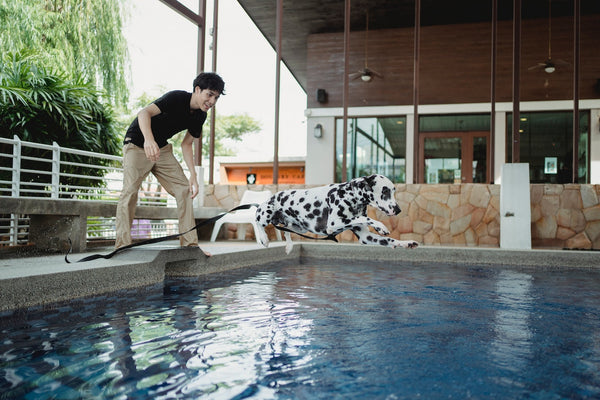Dog Limping But Not in Pain: Limping Causes and Care
Posted by Jeffrey Powers on
No one wants to see their dog start limping. It can be a concerning experience; it’s not always easy to determine what caused the limping to start.
While it’s never normal for your dog to limp, there are many causes, some more serious than others.
So, if your dog is limping but not in pain, we’ll explore possible causes and treatment options.
Related: How to Calm Dogs During a Storm
Dog Limping Checklist: Is It an Emergency?
If you see your dog limping, ask yourself three questions to help determine if it requires an immediate vet visit:
When Did the Limp Start?
Your dog might limp on and off, limp for a minute and then be fine, or it might stick around, either progressively worsening or staying the same.
If your dog is a chronic limper — limping for two weeks or more — it’s time to have a vet determine what’s going on with your puppers. A chronic limp isn’t usually an emergency, but you should try to get in with your vet as soon as you can.
On the other hand, if your dog’s limp started suddenly, you’ll want to keep going down our checklist.
Does your dog occasionally limp due to chronic pain issues? Try our CBD hip and joint dog chews — delicious and effective.
Is the Limp Mild or Severe?
You can tell the limp is mild if your dog still uses the leg in question, even if they try to put less weight on it. In the case of a mild limp, it’s not a bad idea to let them relax for a couple of days to see if it goes away. However, if they don’t return to normal soon, we recommend scheduling a check-up with your vet.
You’ll notice immediately if the limping is severe: Your dog will either refuse to put weight on it at all or will gingerly step on it, barely letting their paw hit the ground.
A severe limp is always a reason to see your vet quickly, but the third question will help you determine if it requires an emergency visit or if you can wait until tomorrow to see your regular vet.

Are There Any Other Symptoms?
If you notice any of the following accompanying your dog’s limp, you should call your vet ASAP or visit an emergency clinic:
- Extreme pain: Trembling, behavioral changes, unusual vocalizations, etc.
- Bleeding
- Swelling in the leg
- Trouble breathing
- Fever
- Lethargy
- Vomiting
- Disorientation
My Dog Is Limping But Not in Pain: What Caused It?
There are many reasons why your dog might be limping, from underlying conditions, infections, and arthritis to physical trauma.
If your pup limps on their front leg, likely causes include:
- Shoulder injury or instability
- A joint disease called osteochondritis dissecans
- Elbow dysplasia
- Bicep inflammation or injury
Limping on a back leg typically has different causes, including:
- Hip dysplasia
- Ligament rupture
- Muscle or ligament strain
- Other musculoskeletal conditions
Other causes of limping that can affect any leg or paw include:
- Bone fractures
- Torn nails
- Dislocation
- Bites or stings
- Paw pad trauma
- Osteoarthritis
- Infections
- Physical wounds
Related: How to Calm Down Hyper Dogs
Common Signs of Different Types of Limping in Dogs
If your pup limps when getting up in the morning or after a nap, osteoarthritis is a common cause, especially if they seem to get some relief after getting active.
Other limps come and go — physical injuries like muscle strains will often seem to go away when your pup rests but will come back once they start running around during playtime.
In addition, developmental diseases and tick-borne illnesses can lead to a limp that changes legs.
If your dog gets more exercise than usual and begins to limp, it’s entirely possible that their muscles are just sore and they need some rest. Or, it could be due to a bruise, wound, sprain, or torn nail.
Caring for Your Limping Dog: How Can You Help?
First, examine your dog’s injured leg or paw if they’re limping but it’s not an emergency situation.
Gently look at their foot and leg and see if there are any of the following:
- Cuts or bruises
- Warm or tender spots
- Instability in the leg
- Minor swelling
You’ll also want to examine their paw pad and look between their toes to check for torn nails, paw pad wounds, or a foreign object stuck in their foot.
If you hear or feel grinding in your dog’s joints, arthritis could be the cause.
Did you find a minor wound? Gently clean it with warm water and a non-fragrant soap. If you can’t tell how bad the wound is, call your vet instead.Did you notice minor swelling? Encourage your dog to rest and ice the area for 15-20 minutes at a time. If it worsens or persists for more than a day, it warrants a vet visit.
Is there something stuck in their paw? You can attempt to pull out a splinter or shard of glass with tweezers. Be careful: Your dog might show aggression if they’re in pain. If you can’t get the object out, or don’t feel comfortable trying, contact your vet for help.
However, many causes of limping won’t show external signs. If you determine their limp is mild, let them rest and do your best to keep them comfortable and quiet. In any case, if your dog’s limping doesn’t improve within a day or two, you’ll want to have your vet examine them for possible causes.

Natural Remedies to Help Relieve Your Dog’s Limping At Home
Depending on the cause of your dog’s limping, your vet might recommend one of the following natural supplements to help them get relief at home:
Glucosamine: This natural compound aids in joint function and cartilage health. It helps lubricate joints, reduce inflammation, and improve mobility in dogs with arthritis.
Omega-3: Dietary fatty acids can reduce inflammation and improve your dog’s discomfort associated with joint issues and limping.
CBD: Cornell University researchers found that CBD can help increase mobility and relieve pain without the side effects associated with conventional treatments. Related: Hemp vs. CBD for Dogs
No matter why your dog is limping, we recommend seeing your regular vet if it doesn’t go away within a couple of days. In addition, don’t give your dog any new supplements (natural or not) without your vet’s approval.
Here’s to the health of your pup.
Want to see if natural remedies can help your dog’s limping? Try our doggy CBD chews, or write to us with any questions.
